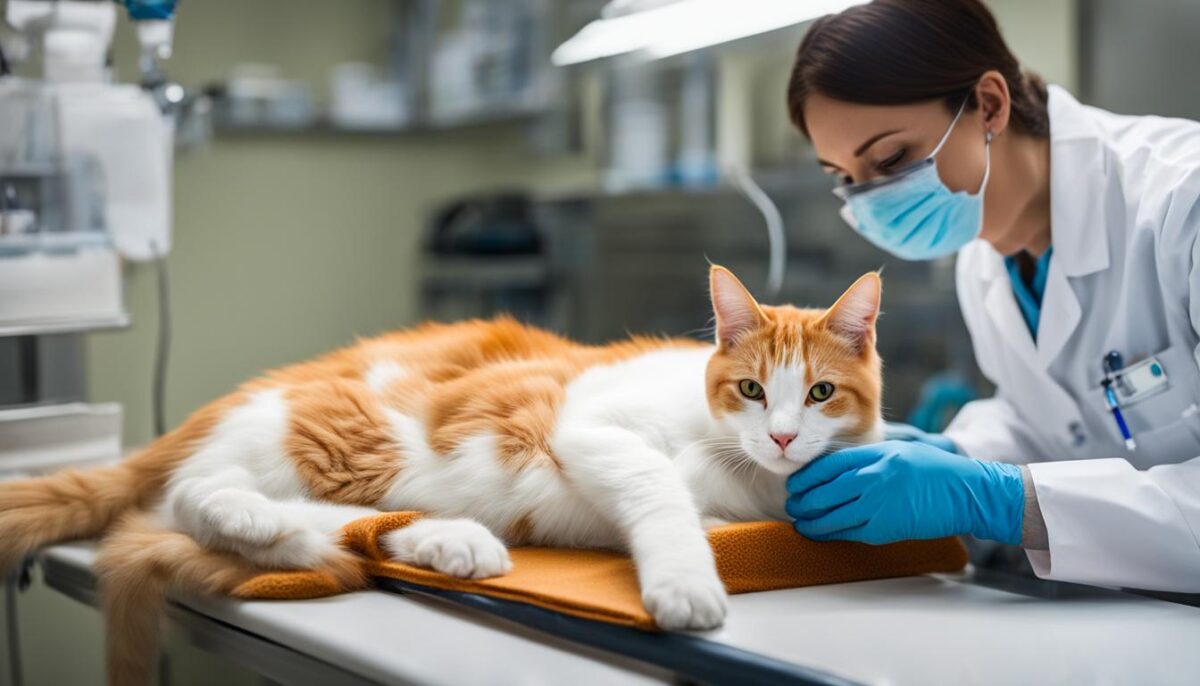If your pet is scratching a lot or you see bald spots on their skin, it could be a sign of a skin condition in pets called mange. Mange in cats and dogs is caused by mites that are super small parasites. These mites can make your pet very itchy and uncomfortable. But don’t worry, mange can be fixed with help from a vet.
Most times, mange happens more in dogs than in cats. So, if you have a pet dog with mange, known as sarcoptic mange, it’s possible for your cat to catch it too. This is because the mites that cause mange don’t really mind who they live on, meaning they could move from your dog to your cat. And there’s also something called feline mange—when mites make a home on a cat. Mites are not good. They bite and can make the skin of your pet red and sore.
These tiny bugs can spread to other animals and even to humans because mange is a zoonotic disease. That means it’s really important to take care of it quickly if your furry friend gets it. But don’t stress – your vet knows just what to do to make the mange go away and keep your pets feeling happy!
Key Takeaways
- Mange is a skin problem in cats and dogs caused by mites.
- It’s more common in dogs but cats can catch it too.
- Mites make your pet itchy and can cause hair loss and red skin.
- Mange is a zoonotic disease, meaning it can spread to humans as well.
- If your pet has mange, they need to see a vet to get better.
- Keeping everything clean can help prevent your pets from getting mange.
Understanding Mange in Cats and Dogs
When your kitty or puppy is itching a whole lot, they might have a mange skin problem. This is caused by tiny bugs called mites that live in their skin and fur. These mites can really bother your pets, making them feel itchy and sore.
What Is Mange and How Does It Affect Your Pets?
Mange is when your pet has itchy skin because of mites. You can’t really see these pet parasites, but they make your pets scratch a lot. Imagine having a bug bite that never stops itching—that’s what mange feels like for cats and dogs.
The Different Types of Mange Mites in Cats
Did you know that cats can have different tiny mite bugs living on them? There’s one kind, the ear mite, that loves to stay in pets’ ears. There are also other kinds that can cause your pet’s skin to get all red and sore, and make their fur fall out.
Spotting the Signs: Symptoms of Mange in Felines
If your cat has mange, you might see them scratching themselves more than usual. They could have spots with no fur, or places where the skin looks red and angry. If your kitty is really upset and keeps shaking their head, it might be because of ear mites bothering them.
- Itchy skin: Your pet won’t stop scratching.
- Hair loss in cats: You might see patches where there’s no fur.
- Inflamed skin and mange sores: The skin can get really red and have sores.
- Upset pets: Your cat or dog may seem unhappy because they feel so itchy.
Knowing all about these itchy skin problems can help you keep your furry friends happy and healthy. If you think your pet has mange, a quick trip to the vet can help make them feel better!
Inspecting the Mites: Diagnosis and Identification
When your cat is itchy and you think they might have mange, your friendly vet is the one who can tell for sure. They do a special test that’s not too tricky. It’s like solving a tiny mystery on your cat’s skin. Here’s what happens when you visit the clinic.
Professional Diagnosis: The Role of Skin Scrapings
If your cat can’t stop scratching, it’s time to check for mites. Diagnosing mange starts with your vet taking a small bit of skin, almost like a pinch. Don’t worry; it’s fast. They use this little piece to look really closely under a microscope, checking for tiny bugs that might be causing the trouble. This is what we call a vet skin scraping. It helps to find mites if they are hiding there. This is an important part of mange detection because seeing the mites tells the vet exactly what’s bugging your cat.
Treating Your Cat’s Mange: What To Expect at the Vet
If the vet finds mites, they’ll know how to help. Your cat might need some mange treatment and there are different kinds, like lotions or pills. Pet medications will help your cat feel better and stop the itch. The vet might also suggest special clean-smelling shampoos that help your cat’s skin heal. If you have more pets at home, they might need a check-up too, to keep everyone healthy and mite-free. Veterinary care for mange is all about getting the right treatment to help your pet’s skin heal up nice and smooth.
Remember, if you think your kitty has a case of the itches that won’t quit, a quick trip to the vet can sort it out. They have all the tools for mange detection and can get your furball on the path to happy, healthy skin healing. Keep an eye out, give them love, and you’ll both be feeling purr-fect in no time!
Mange Prevention: Keeping Your Cat Healthy
If you love your furry friends, you must know about preventing mange. It’s all about keeping your pet healthy. So, let’s make sure your kitty stays happy and itch-free!
First things first, a clean pet environment is super important. That means washing your cat’s bedding and toys often. Don’t forget about combing their fur to keep away those sneaky mites!
To stop mange from bothering your cat, feed them really good food. This helps with their immune support. When your cat has strong health shields, those mites don’t stand a chance!
Here’s a simple list to follow:
- Always keep your cat’s living area clean and comfy.
- Give them the right kind of food to help them be strong.
- Take your cat for check-ups at the vet to make sure they’re doing great.
- Keep an eye on your cat. If they seem itchy or not happy, go see the vet.
Lastly, remember that hanging out with other sick cats or animals could make it easy for mites to come over. Try having playdates with only healthy pets!
It’s simple, right? Keep things clean, feed your cat well, and keep them away from sick animals. That’s the best way to stop mange and keep your cat purring happily!
Can Cats Get Mange from Dogs?
Have you ever wondered if your cat can get sick with something called mange from your dog? The answer is yes. Mange doesn’t really care who it bothers—cats, dogs, or any other furry friends that live together might catch it from each other.
The Risk of Cross-Species Transmission
When pets live close, like they do in your home, there is something called cross-species mite transmission. What this means is bugs called mites can move from one type of pet to another. So, those little bugs can hop from your dog to your cat. This kind of bug move can make your pets really itchy.
Contagion in the Household: How to Protect Your Pets
We need good plans to keep our pets safe. Let’s look at some smart ways for contagion prevention to help stop your furry friends from catching mange from each other, especially in multi-pet households.
- Keep your pets apart if one starts feeling itchy and scratchy.
- Clean their beds, toys, and hang-out spots with pet-safe cleaners.
- Use the meds your vet gives to your sick pet, and maybe even the healthy ones too.
- Keep your pets from roaming outside where they could meet another itchy animal.
When we do these things, we can be good zoonotic disease safeguards. This means we’re protecting our pets and even ourselves from getting sick. Pets love to be with us, but if one isn’t feeling well, give it some alone time to get better and keep everyone else at home safe.
| Action | Why It Helps | How It Protects |
|---|---|---|
| Keep pets separate | Stops bugs from jumping pet to pet | Safeguards other pets from getting mange |
| Clean their things | Makes bugs go away | Keeps the home safe from mites |
| Use vet meds | Kills off the itchy mites | Prevents the spread of mange |
| Limit outdoor time | Lowers chances of meeting sick animals | Reduces risk of new bug friends |
Final Thoughts on Mange in Pets
Mange can seem pretty scary when it happens to your favorite furry friends. But, don’t worry too much. If you watch your cats and dogs closely and see them scratching or getting sore spots, it’s time for a trip to the vet. If they do have mange, the vet can help and make them feel all better again.
Your job is to make sure your pets stay healthy and clean. Remember, mange management is all about pet health awareness. When you know how to take care of your pets, you’re helping stop mange from bothering them.
Here are some final thoughts on mange in pets:
- Spot any skin troubles early, and get help if your pet is itchy.
- Keep your pet’s sleeping spot nice and clean.
- Don’t forget to feed them good food to help their bodies stay strong!
So, stay alert and keep your pets happy, and you’ll do just fine!
Additional Resources and Recommendations
If you’re looking for more helpful information about mange in pets, resources are just a click away. Online, PetMD and WebMD are great places to start. They have easy-to-read articles that explain what mange is and how to help your furry friends if they have this itchy skin problem. You can learn about what causes mange, the signs to look out for, and how to make sure your pets stay comfortable and healthy.
For those who enjoy learning all the details, the Companion Animal Parasite Council (CAPC) offers Vet Guidelines that dive deep into the world of mange mites. This knowledge can help you understand the science behind mange and how to protect your pets. These resources are packed with expert advice and can be a huge help if you’re dealing with this tricky health issue!
Keep in mind, your vet is the best person to talk to about taking care of your cat or dog. They know your pet’s health the best and can give you the right medicine or treatment if there’s a mange problem. So, if your pet is scratching more than usual or you notice some bare spots on their skin, make a visit to your vet. They are the ones who can help you make sure your pet stays happy, healthy, and mange-free!
FAQ
What is mange and how can it affect my cat or dog?
Mange is a skin condition in pets, primarily caused by a mite infestation. These parasites can lead to itching, hair loss, inflamed skin, and in severe cases, sores and infections.
Are there different types of mange mites that can affect cats?
Yes, cats can be affected by various types of mange mites, including feline scabies caused by Notoedres cati, ear mites (Otodectes cynotis), and Demodex mites leading to feline demodicosis. Each type causes different symptoms and requires a specific treatment approach.
How can I tell if my cat has mange?
Symptoms of mange in cats include excessive scratching, hair loss, flaky or inflamed skin, and in the case of ear mites, head shaking and wax buildup in the ears. If you notice these symptoms, it’s best to consult a vet for a proper diagnosis.
How will a vet diagnose mange in my pet?
Vets generally perform a skin scraping to collect a sample of your pet’s skin cells, which will be examined under a microscope to detect the presence of mites and diagnose mange.
What can I expect in terms of treatment if my cat has mange?
Treatment may involve topical ointments, oral medications, special shampoos, and possibly injections, depending on the type and severity of the mange. Your vet will recommend the best treatment for your pet’s specific condition.
How can I prevent my cat from getting mange?
Keep your cat healthy with a strong immune system through proper nutrition and a clean living environment. Regular vet check-ups and avoiding contact with other infected animals can also prevent mange.
Is it possible for my cat to get mange from my dog?
Yes, cats can contract mange from dogs, especially sarcoptic mange, which is contagious across species. If one of your pets is diagnosed with mange, it’s necessary to treat all pets in the household and thoroughly clean their environment.
What steps should I take if one of my pets is diagnosed with mange to protect the others?
Isolate the infected pet, seek veterinary treatment immediately, and follow your vet’s instructions carefully. Clean and disinfect your home including bedding, toys, and any areas where the pet spends time. It’s also crucial to wash your hands after handling the infected pet to prevent zoonotic transmission.
Can humans be affected by mites that cause mange in pets?
Some mites, like those causing sarcoptic mange, can temporarily infest human skin and cause itching and irritation, but they do not survive long on humans. Proper hygiene and treating your pets can reduce the risk of human infestations.
Where can I find more information about mange and pet care?
For more information about mange and general pet health, you can visit reputable websites such as PetMD, WebMD, and consult the CAPC Vet Guidelines. Always speak to your own vet for advice tailored to your pet’s needs.


